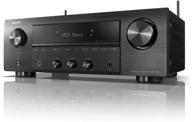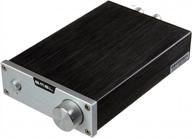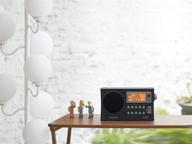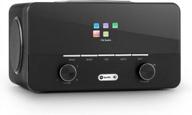
Review on 🔊 Powerful 200W Bluetooth 5.0 Amplifier Board TPA3116 with High Fidelity Stereo, LC Filter for Clear Audio - YEMIUGO by Aaron Kindler

Big bang for your buck
This amp is based on the TPA3116D2 as a class D amp Without a doubt one of the best audio chips on the market. In fact, it's so good that with a few mods this gem can be turned into audiophile quality. The internet is full of literature and modifications. And for the bass lovers, it's possible to boost the bass below 20Hz by swapping out a few capacitors (see Texas Instruments datasheet) (according to my testing, this could have already been done). But wait a minute, isn't the TPA311D2 limited to that? 50w but the listing says this is a 100w amp? The listing is correct and the unit is a true 2x100W amp. pure 100 watts. Of course, the maximum output power depends on the voltage and current of your power supply. This version uses 35V capacitors. Some vendors sell the same board with 25V capacitors. DO NOT buy any of these circuit boards as these covers are under-priced. Before we continue, I want to dispel a few myths. Many people assume that a 20W amp is twice as loud as a 10W amp. That is not true. When buying an amplifier, remember: Doubling the output power. (W) increases the volume by 3 dB. A tenfold increase in output power results in a 10dB increase, or twice as loud a sound. So a 10W amp is twice as loud as a 1W amp. So a 100W amp is twice as loud as a 10W amp. So a 1000W amp is twice as loud as a 100W amp. The next issue we need to consider is the input signal level. Obviously, the higher the amplitude of the input signal, the louder the amplifier plays. Consumer level!) Consumer audio (aka -10dBV) has a maximum PtP input of 0.894V. Professional audio (aka +4dBu) has a maximum PtP input of 3.472V. In other words, this amp has plenty of headroom for consumer audio. 8 ohm car speakers typically have an impedance of 4 ohms. What is Class D? No, D does not mean digital. In the 70's and 80's most amplifiers were Class A or B. Class A has an efficiency of 20-50% (remember those bulky, powerful boxes that could heat a house in winter?) Class B has a maximum Efficiency of 78%. This jewel has a theoretical efficiency of 100%. So don't let this small size fool you! You will notice massive LC filters. Cheaper versions of this amp use RC filters (R=resistor, C=capacitor and L=inductor, which is the best solution). In theory, these RC filters also reduce ripple, but of course they introduce signal loss due to resistance. When choosing LC filters, it is obvious that the manufacturer has not skimped on quality parts. Performance test: I connected a 4.1 ohm dummy load to the amplifier and set the power supply to 24 VDC. Increased the volume just before clipping (you can see some artifacts starting at the top of the signal (not audible). That's a whopping 129.96W peak! or 91.2W RMS. The amp gets pretty hot but this was to be expected Amplifier Amplifier to multiple speakers Bass is pronounced, maybe too pronounced, but it makes the amp sound great and warm on smaller speakers.
- Cool
- Long delivery time
New products
Comments (0)
Top products in 🍿 Home Theater

Bluetooth adapter Baseus BA01 black 1 pc.

95 Review

Experience Hi-Fi Amplification and Alexa Compatibility 🔊 with Denon DRA-800H Network Receiver for Home Theater

15 Review

Silver 160W Stereo Digital Amplifier With Power Adapter - S.M.S.L SA-98E For Enhanced SEO

15 Review

Denon PMA-800NE Hi-Fi Stereo Integrated Amplifier, 85W x 2 Channels, Built-In Phono Pre-Amp, Analog Mode, Advanced High Current Power, Black

20 Review
Another interesting products

Radio receiver Max MR-322 anthracite

14 Review

Experience Dynamic Audio with Panasonic SC-UX100 CD & USB Wireless Bluetooth 300W Mini Hi-Fi System Shelf Stereo

19 Review

Sangean PR-D4W Portable Weather Alert Radio with AM/FM Bandwidth Narrowing and Auto Tracking for Improved Searchability

12 Review

AUNA Connect 150 Black 2.1 Wi-Fi Internet Radio Music Player With MP3 USB Port, AUX & Remote Control - Black

16 Review

